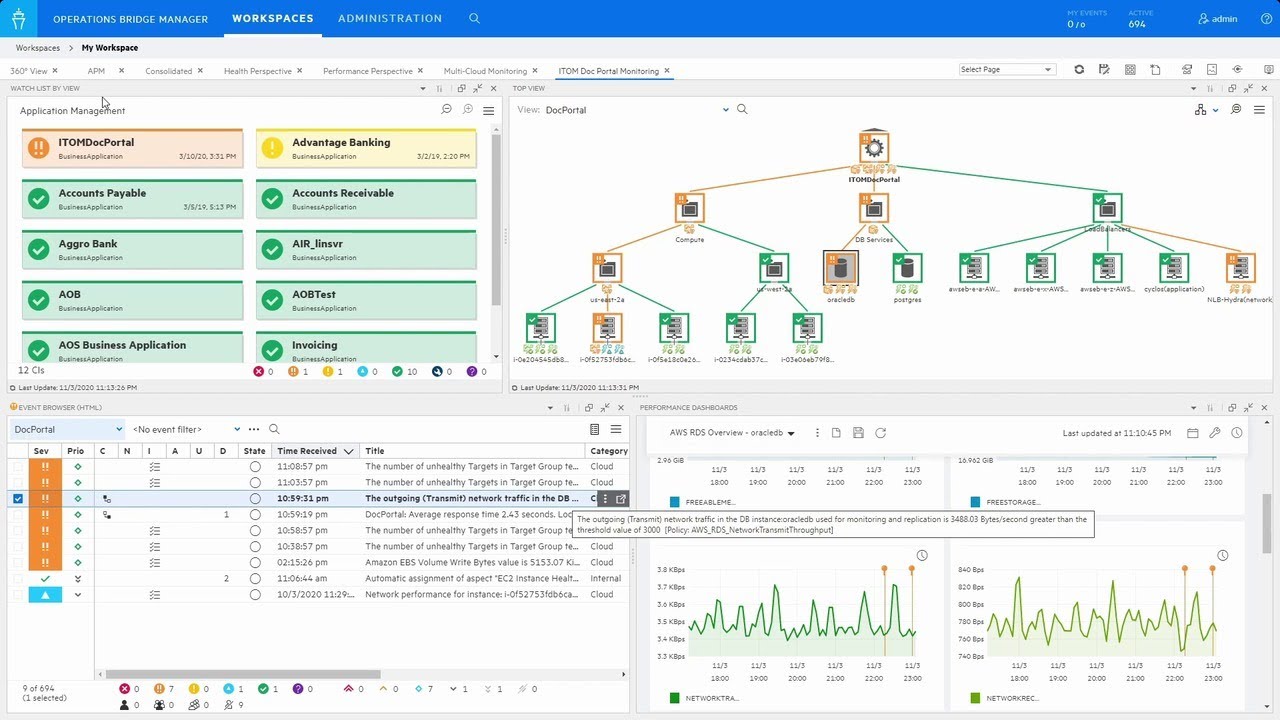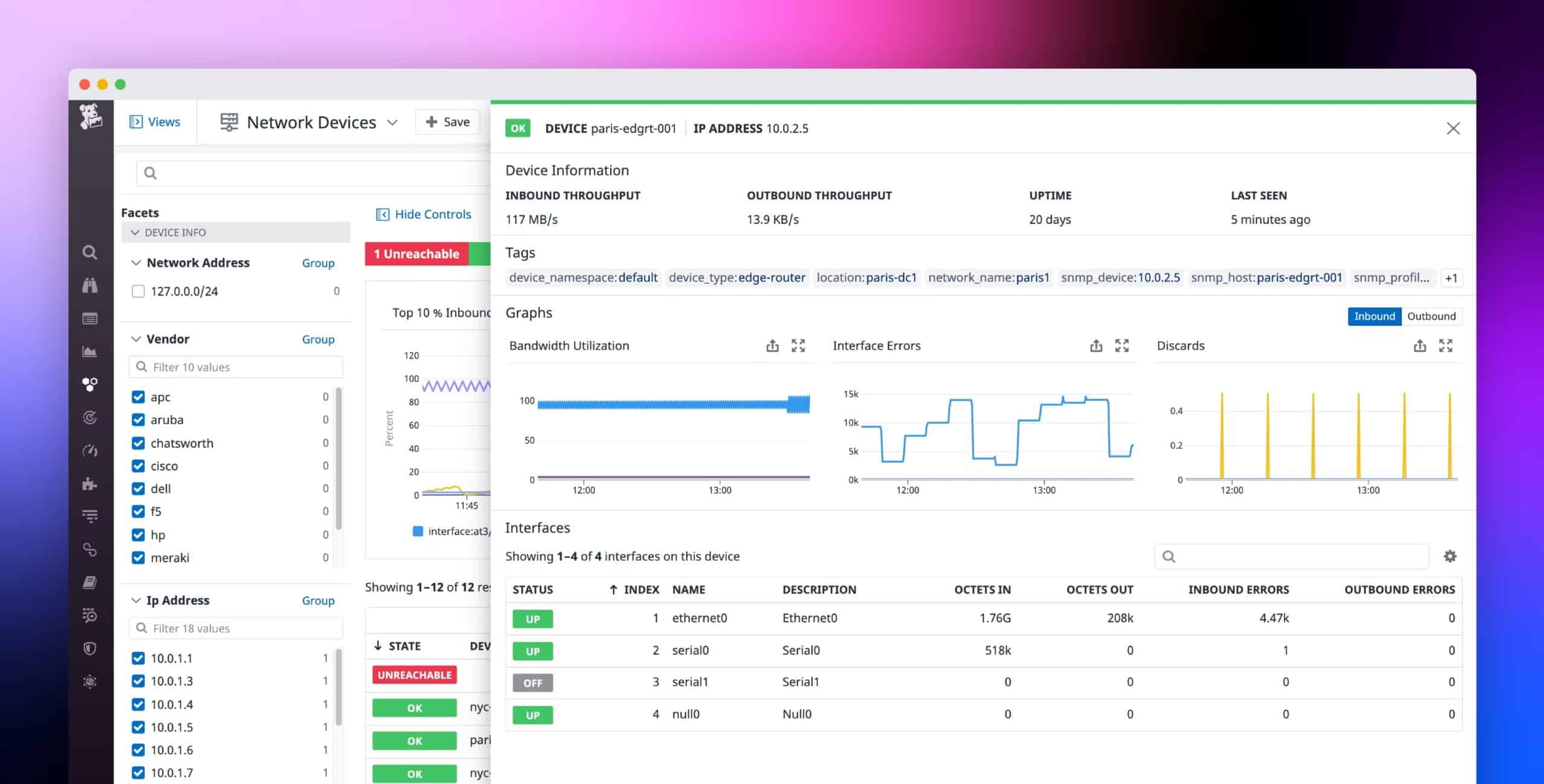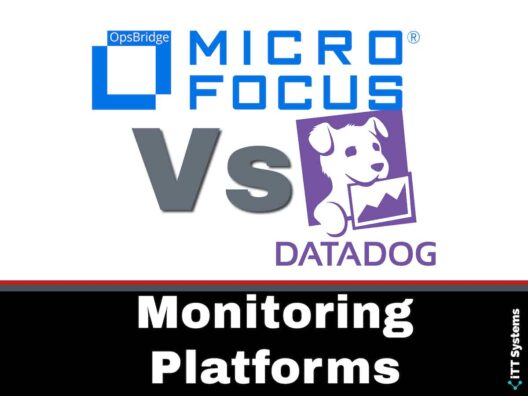As more organizations undergo digital transformation, there's greater pressure on the IT department to cope with these changes. This means they have to suddenly monitor more widespread endpoints and support critical business applications through both on-prem and cloud environments, as organizations go through the transformation.
Unfortunately, all these changes can get overwhelming quickly. This is where platforms like Operations Bridge (OpsBridge) and Datadog come in. In this article, we'll look into what each of these platforms is and how they fare against each other.
What's Operations Bridge?

Operations Bridge (OpsBridge) from Micro Focus is a monitoring platform that collects and consolidates data from existing applications across the network. Using a wide range of capabilities such as analytics and auto-discovery, this platform identifies gaps and remediates data across private, public, and even multi-cloud infrastructure.
Features
- Automates AIOps to reduce false positives.
- Enhances the identification and remediation of errors.
- Provides actionable insights for relevant stakeholders.
- Offers centralized performance and event management across 200+ domains.
- Brings down the Mean-Time-To-Repair (MTTR).
- Proactively monitors end-user experience.
- Facilitates flexible deployments.
In all, OpsBridge automates many routine maintenance tasks related to monitoring and remediation, and in the process, adds extensive value to your business.
What's Datadog?

Datadog is a SaaS-based monitoring and analytics platform that monitors events and performance of your applications, containers, servers, infrastructure components, and more. It collates data from servers, databases, containers, applications, and other network components to provide a unified view of the health and performance of your overall network.
Features
- Provides instant visibility into your cloud environments.
- Monitors the performance of your network.
- Identifies security policy violations.
- Builds compliance and governance.
- Displays the relationships and dependencies across your network components.
- Detects cryptocurrency mining in your environment.
- Offers a centralized view of your services.
- Helps with troubleshooting and remediation.
Overall, Datadog is a monitoring and analytics tool that provides monitoring services for your cloud infrastructure. It comes with many flexible features and reports to ease the monitoring process for your IT and DevOps teams.
Now that you know what each of these platforms is, let's see how they fare against each other across different aspects.
OpsBridge vs Datadog – A Detailed Comparison
In this section, we will pick some important features of monitoring platforms and see how OpsBridge and Datadog perform across these features. The idea here is to help you choose the platform that's a better fit for your organization's needs.
Deployment
Datadog is a SaaS-based platform and works best for cloud applications. The biggest advantage of Datadog is the flexibility that it offers for your organization. Since it doesn't entail any downloads or installs, you don't need expert resources. Further, the maintenance is also handled by Datadog itself, so there's no overhead for you at all. The bonus is that it can work across different operating systems.
OpsBridge, on the other hand, is an automated hybrid IT tool that works well across both cloud and on-prem environments. This platform works best for organizations that have a hybrid environment or those that are looking to migrate from an on-prem to a cloud environment. OpsBridge also offers a ton of flexibility as it has SaaS capabilities as well.
In all, both Datadog and OpsBridge are equally good for cloud environments. However, if you have an on-prem environment, OpsBridge is your choice.
Dashboards and Reports
Datadog offers an intuitive and interactive dashboard experience. No prior technical experience or knowledge is required to use these dashboards. Also, its out-of-the-box reporting templates and graphs help you to see a wide range of information in just the formats you want. You can also create custom dashboards if you can't find a template that displays just the information you want.
Moreover, Datadog offers two broad kinds of dashboards – Screenboards and Timeboards. Screen boards are custom dashboards that can also be used as a storyboard and gives you granular control over every pixel of information that's displayed. Timeboards, on the other hand, display a metric across a period, so you can evaluate the changes during this period. These time boards are highly helpful in troubleshooting.
OpsBridge dashboards are highly informative. But it gives a television feel as it displays KPIs, the status of critical components, data from different sources, and more. It can also give a cluttered feel and require some prior experience to navigate and understand the default view. It can even display business and IT news that is relevant to your business.
However, the biggest advantage is that you can stream this information to a tablet or any other device via a browser.
When you compare these two platforms based on their dashboard capabilities, Datadog is hands-down better as it can be easily customized, offers better views, and is highly intuitive. OpsBridge sure has some catching up to do, especially for displaying information to non-technical users.
Integrations
Both platforms integrate well with many popular apps and services. But when you compare the two,
Datadog integrates with more than 450 apps while OpsBridge is a lot lesser at just around 200. While this won't matter much as 200 is still a lot and is likely to cover the most popular services, still, it's something to know.
From an organization's standpoint, check if the services you want to integrate to are supported by either platform, during your evaluation and decision-making process.
Anomaly Detection
Anomaly detection is an essential part of monitoring as this is the feature that identifies the possible variations. OpsBridge uses AIOps for anomaly detection, which means, it's likely to be precise. Further, OpsBridge also provides pertinent information surrounding this anomaly, so you can get to the root cause at the earliest.
Datadog doesn't use AIOps but has its analytics that gathers information from different sources and analyzes them for variations. To a large extent, Datadog also provides the context around the variation and this can come in handy for fixing the problem at the earliest.
When you compare the two, OpsBridge has an edge here as it uses advanced machine learning and artificial intelligence that only makes this process better over time.
Installation
Datadog requires no downloads or installations at all. Simply choose the service you want and start using it right away. OpsBridge's SaaS is also equally simple and entails no installations. However, if you need the on-prem version, this requires additional resources. But even then, OpsBridge is simple and intuitive to install when compared to many other on-prem solutions.
That said, OpsBridge comes with many components, some of which can be installed only in a containerization mode. This requires some level of expertise and more than one person for installation. So, keep this in mind if you're looking to use OpsBridge for your on-prem environment.
Pricing
Datadog offers three pricing tiers:
- Free
- Pro – $15/host/month
- Enterprise – $23/host/month
OpsBridge doesn't reveal its pricing structure and just wants you to contact the sales team for a custom quote. So, it's hard to know which of the two provides better value for your business.
Customer Service
Before we end, let's look at the customer service options available for each platform. OpsBridge has only a call option and that too, only during business hours. Datadog, on the other hand, offers way more options for its customers. It has chat and email functionalities that users can access at any time. The phone option is available only for enterprise customers.
Besides customer service, both platforms have extensive training materials in the form of documentation and regular webinars. Datadog also offers training through Slack channels if needed while OpsBridge has a well-established community that answers FAQs and common errors.
In all, both platforms come with their pros and cons. So, it's not a question of which of the two is better, rather it's about choosing the one that's a better fit for your organization.
Conclusion
To conclude, monitoring your network and its components and assessing their performance at all times can be arduous, to say the least. OpsBridge and Datadog are two platforms that ease this process for you, as they come with advanced capabilities to monitor every aspect of your network.
However, both platforms are unique in many ways. While Datadog is a SaaS-only platform, OpsBridge is well-suited for both SaaS and on-prem environments. Likewise, OpsBridge offers only phone support while Datadog offers email and chat support as well, along with phone support for Enterprise users only.
Furthermore, Datadog's dashboard is more intuitive and easy to use. Plus, it comes with multiple views that you can leverage for varied purposes. No prior technical knowledge is required to understand and navigate through these dashboards. OpsBridge's dashboard, on the other hand, has a television-like feel and is more of a Business Value Dashboard where the status of different components is displayed continuously.
As you can see, both these platforms are similar but have unique features. So, evaluate what they offer against what you need and make an intelligent decision as to which of the two is a better fit for your organization.




